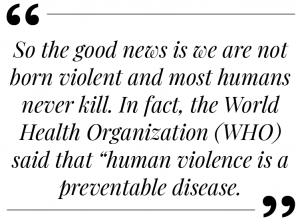 My news feed is filled with stories of violence — physical, emotional, mental, sexual, cultural, institutional, and structural. And all that while we are commemorating the 18-day campaign to end violence against women (November 25 to December 12).
My news feed is filled with stories of violence — physical, emotional, mental, sexual, cultural, institutional, and structural. And all that while we are commemorating the 18-day campaign to end violence against women (November 25 to December 12).
It is easy to think that violence is a normal part of life and that humans are naturally violent. But that thinking has been proven wrong. Violence is learned and it is cultural, rather than natural.
So the good news is we are not born violent and most humans never kill. In fact, the World Health Organization (WHO) said that “human violence is a preventable disease.”
WHO defines violence as “the intentional use of physical force or power, threatened or actual, against oneself, another person, or against a group or community, that either results in or has a high likelihood of resulting in injury, death, psychological harm, maldevelopment or deprivation.”
I read an interesting article written by psychologist Sergio de Dios Gonzalez on “Exploring Your Mind” where he differentiates between aggression and violence.
Gonzalez said aggression is an instinct. We are born with it and it involves a series of physical and chemical processes that happen automatically, without us being aware of it. It is biological which puts us into alert mode if there is some danger. It helps us defend ourselves when necessary and adapt to the environment. It is the survival instinct that enables us to respond defensively towards a threat.
On the other hand, violence is cultural. Gonzalez defines it as “made up of behaviors intended to harm others, for reasons other than our objective need for survival.” He noted that only humans display violent behaviors; no other animal does.
In short, aggression is instinctive but violence is symbolic.
What is natural for humans is the innate tools for responding aggressively when necessary to preserve our life. But the desire and tendency to hurt others for other reasons is taught.
So if violence is learned, it can be unlearned.
Violence is first symbolic before it becomes physical. To be able to kill another human being, he or she must first be dehumanized. To enslave another group of people, one must think of them as inferior or less than oneself. To commit genocide, they must believe the people they are killing are not people but cockroaches.
That is why violence against women is rooted in the belief that women are less than men. And that is why we need to keep on reminding the world that women are humans, too. That women’s rights are human rights.
Same is true with our indigenous peoples. The systematic grabbing of their ancestral lands and the violence against them stem from the thinking that they are inferior beings who do not enjoy the same rights as their colonizers.
The violence committed in the name of religion are all being justified according to their belief that their god is the one true god. Those who do not share the same belief can all go to hell so they are being wiped out from the face of the earth.
Multiple studies have shown that even individuals considered “harmless” can be easily programmed to inflict violence against others without motive or reason.
Where do we learn violence? It starts at home during our childhood.
In an article on Children and Youth Services Review published in 2019, researchers Jeongsuk Kim, Bora Lee, and Naomi Forber suggested that one strong factor in a person’s likelihood of developing pro-violence attitudes is the early experience of violence during the socialization process. Experiences of violence during childhood impart cognitive beliefs condoning violence and increase individuals’ likelihood of engaging in violence.
Children can learn to condone violence in several ways, including verbal reinforcement of violence, observing/witnessing violence, and being the victim of violent acts perpetrated by others such as family and neighbors.
Children might learn that violent behavior is an appropriate problem-solving response from family and community members who justify the use of violence. Such violent socialization is referred to as “advised violence,” meaning that these children received supportive messages regarding violent behavior and coping. This type of socialization is acquired through modeling and reinforcement.
Several previous studies have concluded that encouragement by parents or other adult relatives to engage in aggressive peer interactions can significantly increase a child’s acceptance of violent and retaliatory attitudes.
When children observe violent behaviors being rewarded, they tend to have a positive assessment of violence. For example, if children observe that their father’s violence increases their mother’s submission toward him, they might learn to think that violence is a useful tool for achieving what they want.
Mexican-American actor Edward James Olmos said: “Education is the vaccine against violence.” We can teach our children nonviolence through peace education.
The United Nations Children’s Fund (UNICEF) defines peace education as “a process of promoting the knowledge, skills, attitudes and values needed to bring about behavioral changes that enable children, youth and adults to prevent conflict and violence, resolve conflicts peacefully, and create conditions conducive to peace.”
We must teach our children how to live with what is different and to accept and respect the rights of others. We must also teach children how to know and understand their emotions so they can manage complex emotions such as anger. Role-playing and activities that help children learn to listen and respond to others are some examples that teach young people to solve problems without resorting to violence. Children also need to develop skills in conflict resolution and creative problem solving through dialogue, mediation, and negotiation.
Nonviolence is a valuable life skill for our children to have as they navigate a world that normalizes the use of violence. It is how we change the world and achieve world peace. As peace advocate Colman McCarthy said: “Unless we teach children peace, someone else will teach them violence.”

